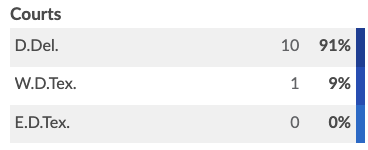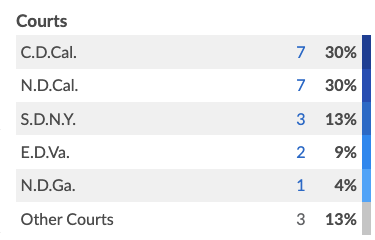Lex Machina briefly examined the analytics for the 3,436 patent cases that terminated in 2023. Slightly less than half, or 1,700 cases, were in one of three district courts: the Western District of Texas, the Eastern District of Texas, or the District of Delaware. This is perhaps not surprising, given that the Western District of Texas, the Eastern District of Texas, and the District of Delaware have been the three most popular district courts for patent case filings since 2020.
But what about the 1,736 cases that terminated in the other federal district courts during the time period? How do the patent findings and case resolutions in these other district courts compare with those in the Western District of Texas, the Eastern District of Texas, and the District of Delaware? The following bullet points are just a sample of what’s possible with Lex Machina analytics:
Patent Findings: Invalidity findings, whether based on section 101, 102, 103 or 112, are uncommon in federal district court. For example: nationally, only 34 patent cases that terminated in 2023 had an invalidity finding based on Section 101 subject matter eligibility at the Rule 12 motion (“Alice motion”) stage. (To clarify, this does not necessarily mean that an invalidity finding based on Section 101 subject matter eligibility terminated the case, but in that particular terminated case, there was an invalidity finding based on Section 101).
- 10 of these cases were in the District of Delaware, and 1 was in the Western District of Texas before Judge Kathleen Cardone. None were in the Eastern District of Texas.

- 23 of these cases were in courts that were not the Western District of Texas, the Eastern District of Texas, or the District of Delaware.

(The “Other Courts” not shown in the chart above consisted of the Northern District of Texas, the District of Nevada, and the District of Massachusetts.)
Case Resolutions: In Lex Machina, a Case Resolution summarizes how the case was resolved, and it is determined when a case terminates. Case Resolutions are organized by Claimant (typically the plaintiff) and Claim Defendant to account for Declaratory Judgment cases, where the defendant brings plaintiff-like claims. Nationally, 76 percent of patent cases that terminated in 2023 were resolved by Likely Settlement; nine percent of patent cases resolved in a Claimant Win, and three percent of patent cases resolved in a Claim Defendant Win.
- In the Western District of Texas, the Eastern District of Texas, and the District of Delaware, four percent of patent cases that terminated in 2023 resolved in a Claimant Win, while three percent of the cases resolved in a Claim Defendant Win. 80 percent of the case resolutions were Likely Settlements.
- Claimant Wins were primarily at the Consent Judgment stage, followed by Trial.
- Claim Defendant Wins were primarily at the Judgment on the Pleadings stage, followed by Trial and Summary Judgment.
- Filtering for Declaratory Judgment cases resulted in an equal number of Claimant and Claim Defendant Wins.
- In courts that were not the Western District of Texas, the Eastern District of Texas, or the District of Delaware, 13 percent of patent cases that terminated in 2023 resolved in a Claimant Win and four percent of patent cases resolved in a Claim Defendant Win. 71 percent of the case resolutions were Likely Settlements.
- Claimant Wins were primarily at the Default Judgment stage, followed by Consent Judgment and Trial.
- Claim Defendant Wins were primarily at the Summary Judgment stage, followed by Judgment on the Pleadings and Trial.
- Filtering for Declaratory Judgment cases resulted in an equal number of Claimant and Claim Defendant Wins.
Lex Machina will be presenting its patent litigation report, which will contain a lot more data and insights, including the PTAB and Federal Circuit, early this year – if you are interested in receiving a copy, please reach out!